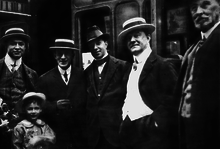C. Dundas Slater
| C. Dundas Slater | |
|---|---|
 Left to right: Theodore Hardeen with his son, Joe Hyman, Harry Day, Lord Northcliffe and C. Dundas Slater. | |
| Occupation | Theatre manager |
Charles Dundas Slater (1852–1912) most well known as C. Dundas Slater was a British theatre manager.[1]
Slater helped to manage London's Empire Theatre (1889-1895) and was the business manager of Alhambra Theatre until 1907. He later managed the London Coliseum until ill health and a failing eyesight affected his ability to work and he was dismissed on June 29, 1912.[1] He briefly appeared in the Auguste and Louis Lumière film Londres, Entrée du cinématographe in 1896.[2]
In June, 1900 Harry Day had helped the magician Harry Houdini arrange an interview with Slater at the Alhambra Theatre.[3] Slater noted that escape feats were not original as Samri Baldwin had performed an escape from handcuffs as early as 1871.[4] He requested a demonstration and challenged Houdini to perform a handcuff escape in the jail section at Scotland Yard. Houdini successfully escaped from the handcuffs with ease, impressing William Melville the first chief of the British Secret Service Bureau. Houdini was booked into the Alhambra Theatre and his magic show was an immediate hit, his salary rose to $300 a week.[5][6]
On July 8, 1912 Slater ordered a taxi to drive him to Charing Cross Hospital. Whilst on the journey in the back seat, Slater shot himself in the head with a revolver. A suicide note was found on his body.[1] It was suggested that his suicide was the result of "temporary insanity" after being dismissed from his post as manager at the London Coliseum.[7][8]
References
- 1 2 3 Frasier, David K. (2005). Suicide in the Entertainment Industry: An Encyclopedia of 840 Twentieth Century Cases. McFarland. p. 294. ISBN 0-7864-2333-1
- ↑ Barnes, John. (1997). The Beginnings of the Cinema in England, 1894-1901. University of Exeter Press. p. 303. ISBN 978-0859895644
- ↑ Gibson, Walter Brown. (1984). The Master Magicians. Citadel Press. p. 173
- ↑ Randi, James; Sugar, Bert Randolph. (1976). Houdini, His Life and Art. Grosset & Dunlap. p. 43. ISBN 978-0448125466
- ↑ Gresham, William Lindsay. (1959). Houdini: The Man Who Walked Through Walls. Holt. pp. 82-83
- ↑ Price, David. (1985). Magic: A Pictorial History of Conjurers in the Theater. Cornwall Books. p. 191. ISBN 0-8453-4738-1
- ↑ Anonymous. (July 9, 1912). Dundas Slater: Well-Known London Vaudeville Manager Shoots Himself in a Cab. The New York Times.
- ↑ "Suicide In A Taxi-Cab: Dismissed Theatre Manager's Act". 13 July 1912.